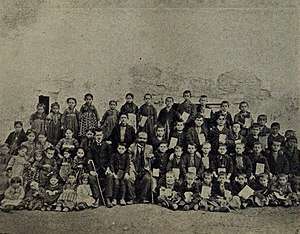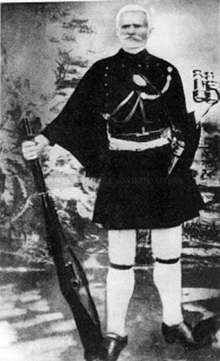Flampouro, Florina
Flampouro (Greek: Φλάμπουρο, Albanian: Negovan[1]) is a village in the central part of Florina regional unit, northern Greece, part of the Perasma municipal unit. The original indigenous name for the village of Flambouro is Negovani and means "cold water" (known for its pure mineral water source) The village's year round population is estimated at 500 people, but in the summer it grows to nearly 700. In the surrounding area many other villages can be found, including Aetos, Skopia, Kato Ydroussa, and Ano Ydroussa.

History
The original village was established in the 1840s by villagers (mostly masons and other tradesmen) who came from Plikati[2] and other villages from Mastorochoria (a region around Mount Gramos) in Epirus. The villagers were Albanians and they settled in an area of West Macedonia that was almost exclusively populated by indigenous (endopi) Macedonians. In the local Slavic dialect, the town is known as Негован (Negovan). There are now three villages in the area that were exclusively settled by Albanians. They are Drosopigi, Flambouro, and Lechovo.[1] In 1842, leading families from Plikati, Epirus purchased the land and forest after negotiating with Osman Ismael Pasha, the Bey from Florina. The village was inhabited many families. The total population at 1900 had reached 1,880.
The villages of Flambouro and Drosopigi were some of the very first villages in its area to have tunnels for the Greek Revolutionaries during the Greek Struggle for Macedonia. Many great revolutionaries stopped at Flambouro as place to heal, rest, or hide. The Hellenic Army leader who most symbolized the Macedonian Struggle, Pavlos Melas, other army leaders, and their troops, used these tunnels for a quick escape from their enemies. In addition, many Flambouro's locals[3] joined the Greek Struggle as fighters or agents. Moreover Flambouro's men captured a Bulgarian general at the time. Legend has it that the head of this general was cut off and brought back to the village so that Pavlos Melas could see it. This is when the village was also known proudly as Flambouro (also meaning bright Greek flag).
Papa Kristo Negovani a native of the village was a representative of the Albanian National Awakening and came in sharp conflict with the Greek-Orthodox hierarchy being against his initiative.[4] During the Balkan Wars (1912-1913) the area came under the control of the Greek forces. The Treaty of London would cease the area to Greece, and the borders were confirmed by the Paris Peace Conference, 1919.
When the World War II hit Europe, Greece suffered a lot, as did Flambouro. In the Battle of Greece (6–30 April 1941), the country faced three Axis powers: Nazi Germany, the Kingdom of Italy and the Kingdom of Bulgaria. Their alliance won the conflict and established an Axis occupation of Greece. The men of Flambouro went on to fight Nazi occupation as the women took control of the village and defended it also. Following the German devastation of Flambouro, the people of the village set out to rebuild it to its original glory. From April 1944 till April 1947 the villagers was rebuilt. The end of World War II was followed in Greece by the Greek Civil War between the Democratic Army of Greece and the Hellenic Army. In the first stages of the civil war many communist-led guerrillas stopped at the village as a hiding place. On April 7, 1947, the Greek government under Dimitrios Maximos adopted a policy of forced relocation for certain villages that were strategic for the guerrillas. Luckily, the village of Flambouro was already loyal and occupied by the Hellenic Army, however, many children were sent to communist countries such as Poland, Romania, Czechoslovakia, and the USSR as refugees. These children were known as Flambouro's lost generation. Other village natives fled with the aid of the Truman Doctrine to the United States in hope to find job to send money to the rest of their families.
In the 1950s and 1960s a new era was coming about in Greece, it was the time of moving. Many families, because of economic conditions, from all around Greece started to emigrate, becoming part of the Greek diaspora. Individuals and families who emigrated from Flambouro mostly went to the United States, Canada, West Germany, and Australia in search of a new life. Some went with the intention to make money and return, but many did not return to Greece and left their villages in their past.
At present, the cities of Rochester (New York) and Adelaide (South Australia) have the largest concentration of immigrants and families that trace their roots from Flambouro. Many people still visit Flambouro to this day and always keep it their hearts as many Flambouryiotes (people from Flambouro) say. The village today also has a hotel where many Greeks from other regions of Greece come to the Florina region for camping, relaxation and an appreciation for the wonderful nature of Macedonia. There are still people who live there but not as many as there were in 1900s.

Notable people
- Papa Kristo Negovani, Albanian religious leader and writer
- Koçi Xoxe, former Albanian minister of Defence in communist Albania
- Georgios Seridis, Greek guerilla leader during the Greek Struggle for Macedonia
- Evangelos Zissis
- Louka
- George Pateras
- Stergios Tavelaris
References
- Nathalie Clayer (1 January 2007). Aux origines du nationalisme albanais: la naissance d'une nation majoritairement musulmane en Europe. KARTHALA Editions. p. 141. ISBN 978-2-84586-816-8.
Dans la région de Florina se trouvaient trois villages en partie peuplés d'albanophones : Negovan, Bellkamen et Rehovë.
- Johannes Faensen (1980). Die albanische Nationalbewegung. in Komm. bei O. Harrassowitz. p. 133.
Negovan und das benachbarte Bellkamen, damals je 300 Häuser groß, hatten albanische Einwohner, die um die Mitte des 19. Jahrhunderts aus Plikat, Kreis Kolonja,...
- I.S. Koliopoulos, I.D. Michailidis, K. S. Papanikolaou, Αφανείς Γηγενείς Μακεδονομάχοι (1903-1913), Thessaloniki, Society For Macedonian Studies – University Studio Press, 2008, p. 176-177. Some of these men were the guerilla leaders Georgios Seridis and Ilias Pinopoulos, Konstantinos Vassos who was executed by the komitandjis in 1905, Ilias Kolepina who was member of Ioannis Poulakas group, Georgios Nikolaidis who also fought as a minor guerilla leader during the Balkan Wars etc
- Schwandner-Sievers, Stephanie; Fischer, Bernd Jürgen (2002). Albanian identities: myth and history. Indiana University Press. p. 55. ISBN 0-253-21570-6.
Notes
- Most of the article is edited and translated from the Florina Prefecture Historical Society